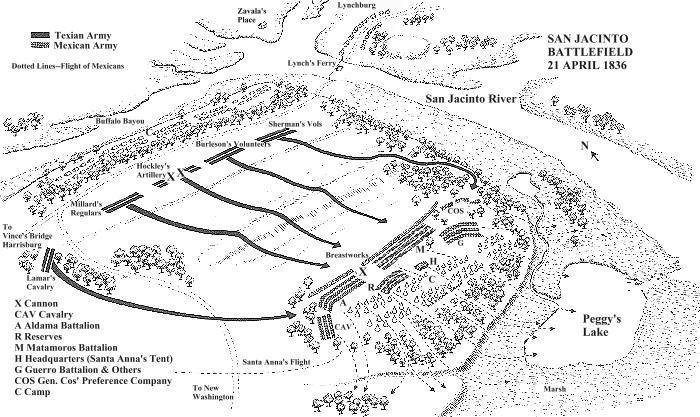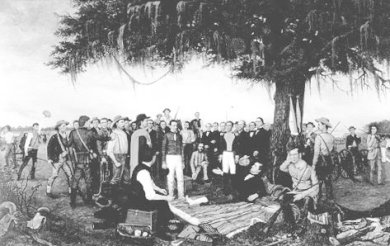On April 19 1836, General Sam Houston addressed his troops, "This morning we are in preparation to meet Santa Anna. It is the only chance of saving Texas. From time to time I have looked for reinforcements in vain: We will only have about 700 men to march with besides the camp guard. We go to conquer. It is wisdom growing out of necessity to meet the enemy. Now every consideration enforces it. The troops are in fine spirits and now is the time for action. We shall use our best efforts to fight the enemy to such advantage as will insure victory though the odds, are greatly against us.
"I leave the result in the hands of a wise God, and rely upon his providence. My country will do justice to those who serve her. The rights for which we fight will be secure and Texas Free!"
After those words Sam Houston and his small Texas army retreated eastward ahead of the Mexican army. Avowing to avenge the cold-blooded murder of their countrymen at the Alamo and Goliad, his troops were becoming increasingly impatient and wanted to stop and fight. However, against popular opinion and almost everyone else's wishes, Houston had a plan. He marched his men down Buffalo Bayou to within a half a mile of it joined the San Jacinto River. Here, the army prepared their defenses on the edge of a grove of trees. Their rear was protected by timber and the bayou, while before them was an open prairie. While retreating General Houston, had maneuvered his men into the positions he desired and allowed Santa Anna to pursue them right into the jaws of a very clever trap.
The following morning about 10 a.m. on April 20, 1836, Mexican General Antonio Lopez de Santa Anna came marching across the prairie in battle array. A volley from the Texan's "Twin Sisters" artillery brought him to a sudden halt. Falling back to a clump of trees a quarter of a mile distant, Santa Anna formed in line of battle. Colonel Sidney Sherman, at the head of the Texas cavalry, charged the Mexican army, but accomplished little except to inspire the Texans with fresh enthusiasm for the following day. The first shot of San Jacinto had been fired. It had only been a skirmish but Houston was satisfied with the results. The fate of Texas hung in the balance and the weight of justice was on the side of Texas
The 21st of April dawned bright and beautiful. The main forces of the Texas army were there, totaling about 750 men. They faced over 1500 of the enemy. The Mexican soldiers felt very secure and full of pride after massacring the Texas army at the Alamo and Goliad, then burning towns and killing Texans on there way east during the previous few weeks.
Early that morning, Houston sent Deaf Smith, with two or three men, to destroy Vince's bridge over which the Mexican army had passed, thus cutting off their only available escape.
General Houston held off his attack until about four o'clock that afternoon. Not only would the western sun be shining directly in the enemy's face, but most of the officers were having their afternoon siesta. General Santa Anna was in his tent with Emily West, who was a pretty, intelligent sophisticated mulatto slave girl he had picked up along the route. She was later known as the yellow rose of Texas, for keeping the general's mind off the Texans. The Mexican soldiers had began preparing their evening meal and the enemy was completely surprised.
Rallying to the cry "Remember the Alamo! Remember Goliad!" and determined to emerge victorious, the Texas army rushed forward with relentless fury upon the breastworks of the Mexicans. At the head of the center column rode General Houston.
The Mexican army was drawn up in perfect order, but the Texans rushed on without firing. As they approached the breastworks, the Mexicans greeted them with a stream of bullets, which however, went over their heads. Houston was badly wounded, but the Texans rushed forward. Each man reserved his fire until he could choose his target, then before the Mexicans could reload, the Texans discharged their rifles into their very breasts. Without bayonets, the Texans converted their rifles into war clubs. A desperate hand-to-hand struggle all along the breastworks took place.
When the Texans had, by smashing in the skulls of the Mexicans, broken off their rifles at the breech, they flung the remains at the enemy, and drawing their pistols, continued the slaughter. When their pistols were emptied they drew their bowie knives and continued to fight until victory.
Twenty minutes after the initial charge the battle was over and 630 Mexicans were dead, 208 wounded and 730 had been taken as prisoners. Only three Texans lost their lives in the fight, 34 were wounded, six mortally. The battle for Texas was won.
(Click here for enlargement)

A Map Of The Battlefield At San Jacinto
The story of Santa Anna's capture was best told by Captain Creed Taylor, one of DeWitt Colonist who fought in the Texas army from Gonzales to San Jacinto, became a Texas Ranger and later fought in the Mexican War with Zachary Taylor. (
Click here for Taylor's full account of the battle)
The scouting party was led by Color Sgt. James A. Sylvester, the gallant young man who bore the "Liberty or Death" flag through the Battle of San Jacinto, the only flag flown on the field by the Texans that day. His men were Joel W. Robinson, A. H. Miles, Charles P. Thompson, Joseph Vermillion, and Siron R. Bostick,
General Santa Anna was discovered crouching in the tall grass along a small hollow. He was first sighted by Jim Sylvester who suddenly rode upon the fugitive. The General had on a corporal's uniform and was barefooted. Sylvester signaled his men who were scattered as far as four or five hundred yards away. They came dashing up flourishing their guns and Santa Anna became excited. At that moment that he gave the Masonic sign of distress. Sylvester and Robinson were both Masons and understood the signs, which undoubtedly was the reason the general was not killed on the spot.
The captive was ordered to march ahead on foot toward the camp, but soon be stopped and declared that because of his bare blistered feet he could go no further. Whereupon Miles drew his gun and threatened to fire if he didn't "step along lively." They proceeded some half a mile when the prisoner suddenly stopped and said: "Señor, I cannot walk barefooted any further, even though you kill me." Several of the boys leveled their guns and were ready to shoot, when Robinson spoke up, saying, "Don't kill the poor fellow." He then reached down, took the hand of the prisoner and said, "Get up behind me."
As the party approached General Houston's headquarters, which was under a large live-oak tree, I hailed Bostick and asked: "Si! Who have you got there?" "Don't know Creed, but we think he's a big buck." This was only a few paces from the "dead line" where the Mexican prisoners were being guarded. No sooner had Bostick spoken than I saw several of the prisoners salute and heard them say, "Es el Presidente! Es nuestro General!" (It is the President! It is our general!). Hearing this I hastened to headquarters and I saw and heard everything that occurred in that great moment of our country's history. On reaching headquarters the captive quickly slid down from the horse and was immediately led to Houston. General Almonte was the first man to approach him and at once introduced him to General Houston, who, owing to his wound, did not rise to his feet, but did rise to a sitting posture and very cordially extended his hand which Santa Anna grasped as if it were that of an old friend. I could not see that Santa Anna was unduly excited, though he appeared quite serious. He bore himself with an air of a fearless---I might say, defiant-man, although at that moment the boys, with fury depicted in their faces, were gathering from every quarter and it was with an effort that the guards held them back.

Surrender of Santa Anna, by William H. Huddle
I cannot recall all the conversation between the two generals; but that interview is of record, and a matter of familiar history. I do remember that Santa Anna did not appear "shaky," nor did he ask for an opiate. Meanwhile the crowd continued to gather, and threats, in an undertone, were heard on every side, and I believe that Santa Anna's being a Free Mason was all that saved him on that day. Houston, Sherman, and many others of our officers were Masons and while a number of them doubtless favored the execution of the red-banded monster, yet they were bound to observe their Masonic obligations. I offer this, however, as my opinion and this idea prevailed generally among the men. Comrade Bostick stood near Santa Anna, as if still guarding the captive, watching every movement and listening attentively to all that was said. "Something seemed to give Santa Anna confidence all at once," said Bostick, and I know now what it was. He and Houston were both Free Masons, and the prisoner made the sign of distress, which Houston, as a Mason, heeded. I was told that at the time by one of our men, who was a Mason also, and I am now certain it was the strong tie of fraternal brotherhood that saved Santa Anna's life."
Most people believed that being a Freenason saved Santa Anna's life, William R. Denslow, arthur of 10,000 Famous Freemasons, wrote: "It is said that Santa Anna owed his life to the giving of the Masonic sign of distress, first to James A. Sylvester; secondly to Sam Houston; and thirdly, to a group of Texas soldiers, among whom were John A. Wharton, George W. Hockley, Richard Bache, Dr. J. E. Phelps and others.
Dr. James D. Carter in his book, Masons In Texas, History and Influence to 1846 stated: "It may be that Masons saved the life of Santa Anna but if so, they did not act because he made claim to their mercy as Masons. All of the Masons to whom he appealed knew that Santa Anna disowned Masonry; that further, his many offenses against Texas and Mexican Masons had placed him outside the protection of any Masonic obligation. Santa Anna was saved because the Texas leaders considered him worth more to Texas alive than dead."
The first time he gave the sign to James A. Sylvester probably did save his life. However, Sam Houston and others of the Texans, who could have executed Santa Anna, knew that executing Santa Anna would only make a martyr of him and they certainly didn't want to do that. And, they had no idea who would replace him in the vacuum that would exist if he was executed.
Cooler heads prevailed and Santa Anna was spared, not because of any Masonic connection, but because it was the politically expedient thing to do.
One of the eight inscriptions on the exterior base of the San Jacinto Monument reads: "Measured by its results, San Jacinto was one of the decisive battles of the world. The freedom of Texas from Mexico won here led to annexation and to the Mexican War, resulting in the acquisition by the United States of the states of Texas, New Mexico, Arizona, Nevada, California, Utah, and parts of Colorado, Wyoming, Kansas, and Oklahoma. Almost one-third of the present area of the American nation, nearly a million square miles of territory, changed sovereignty."

Return To First Page

No © Copyright.
brookshire Lodge
Free To Use.
All material in this site may be used
to educate everyone, Masons and
non-Masons alike about Freemasonry
and for the promotion of Freemasonry.



